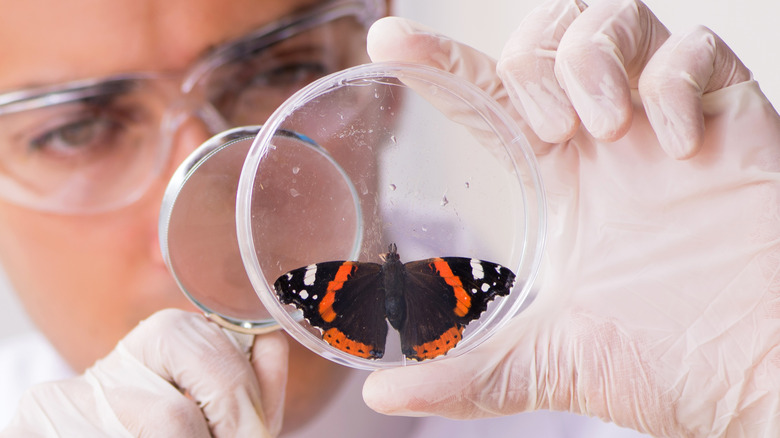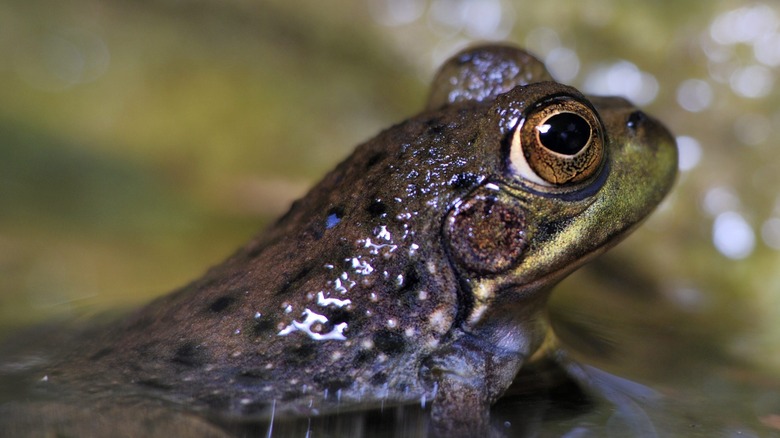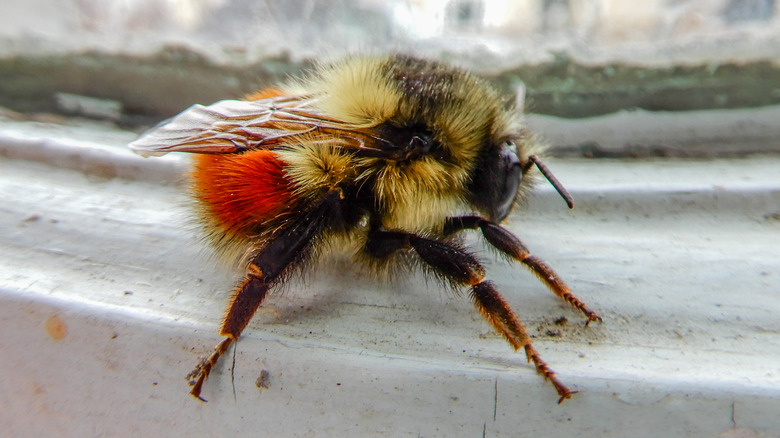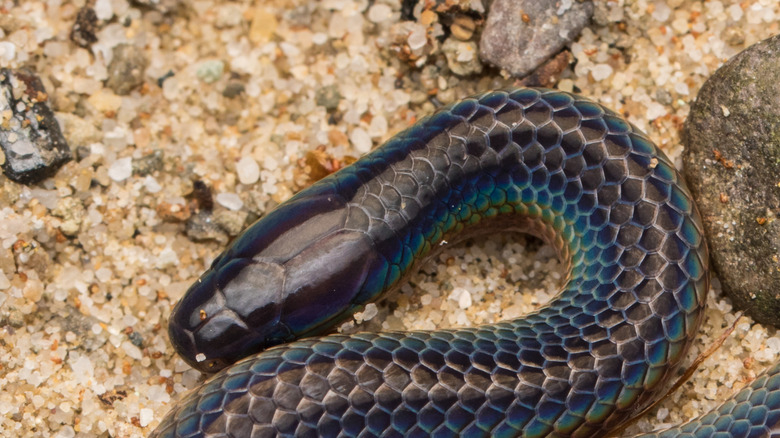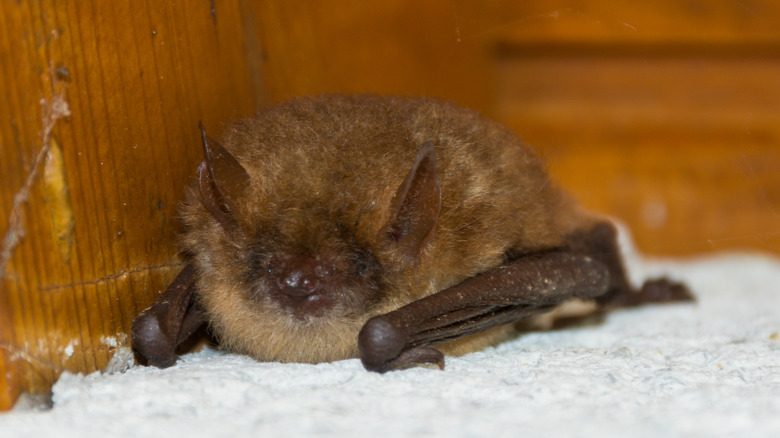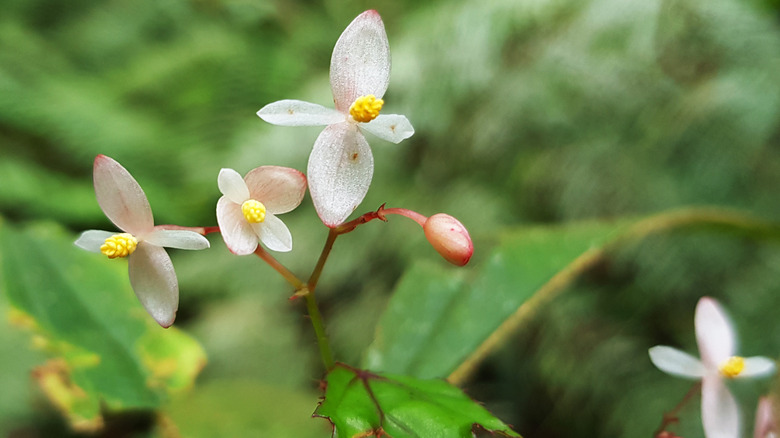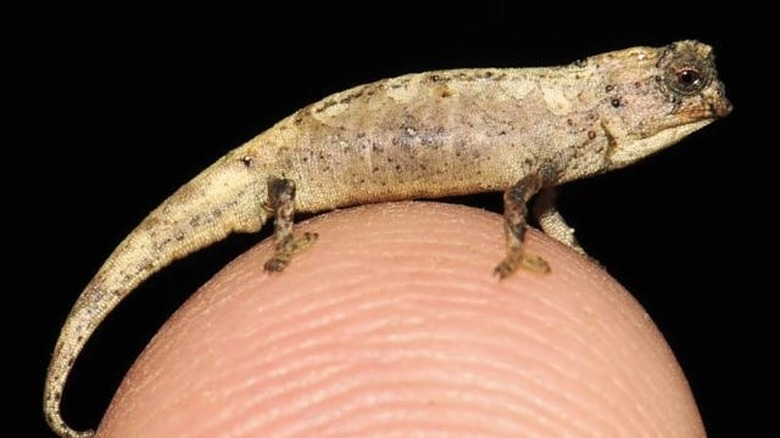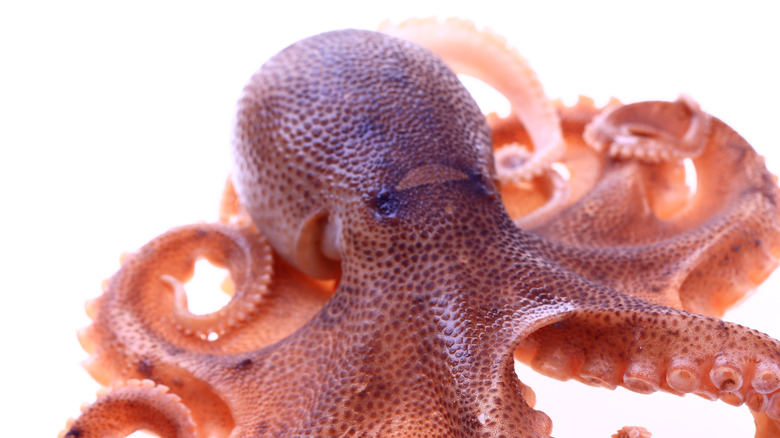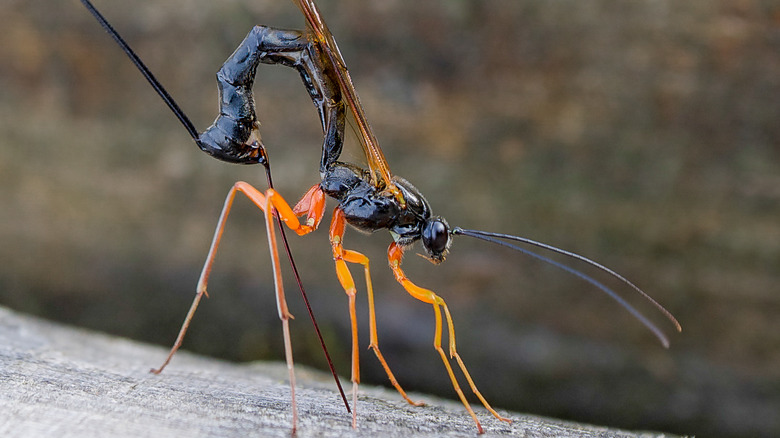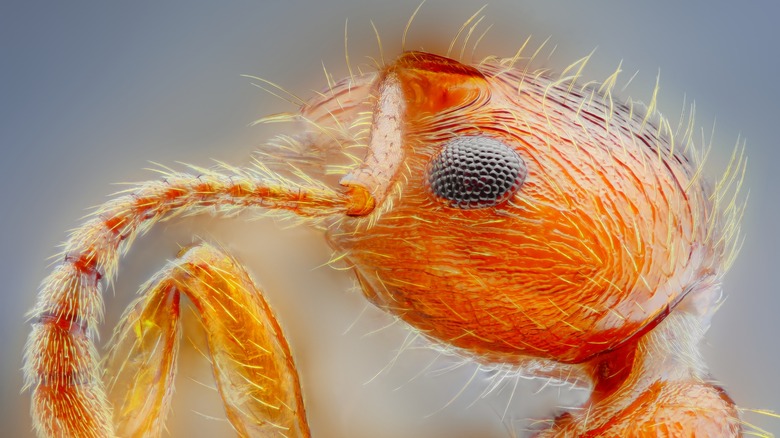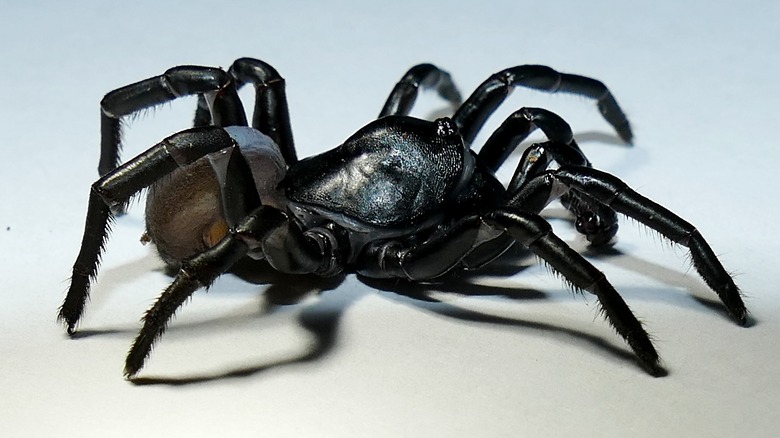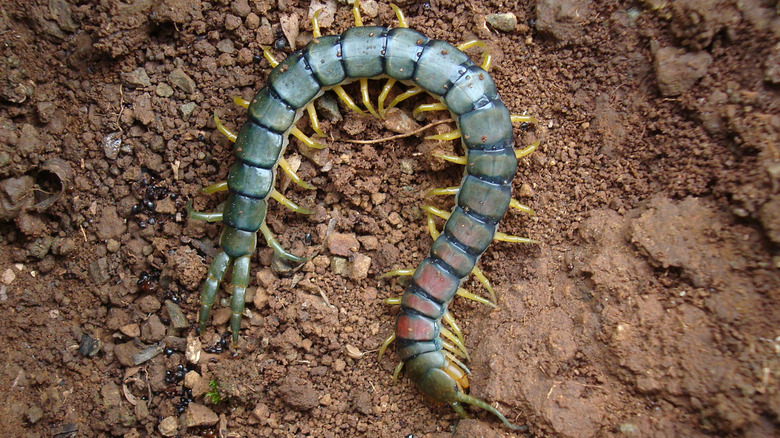Species Recently Discovered That You Probably Haven't Heard Of
Pop quiz: How many living species (which means non-avian dinosaurs and other extinct prehistoric species don't count) do you think there are on the planet? About a hundred thousand? 500,000? A million or two, perhaps? According to a recent estimate from scientists, there are about 8.7 million species of flora and fauna on Earth (via National Geographic). Furthermore, after almost three centuries of patiently and meticulously searching for and cataloguing species, humans have only discovered and described less than 15% of all the different organisms across the globe.
In other words, science is still a long, long way from taking note of every single plant and animal species currently in existence. In fact, there have been many examples of modern-day species that were only properly described long after the last of them died — take, for example, Carcharhinus obsolerus, a type of shark described in 2019 that may have actually gone extinct eight decades earlier (via FlipScience). That's why every new species that experts discover and name is worth celebrating — just like these species that were found and described within the last 10 years.
A Philippine fanged frog hiding in plain sight
Believe it or not, approximately 70% of all species on Earth can be found in the forests, mountains, and waters of just 17 countries (via World Atlas). These so-called "megadiverse countries" make up less than 10% of Earth's surface.
The Philippines is one of them, which is hardly surprising. After all, this archipelago of over 7,000 islands has both the world's greatest concentration of unique mammal species (via FlipScience) and the "Center of the Center" of marine biodiversity (via the California Academy of Sciences). Given the level of biodiversity in the Philippines, some species are bound to go undetected for a long time — just like the Mindoro fanged frog, which stayed under the radar for a century.
According to Sci-News, scientists first obtained genetic samples of this amphibian from the island of Mindoro several years ago but initially didn't analyze them because they looked so similar to another species that was already known to science. However, experts had an inkling that this might be a new type of frog, because of its different habitat and unique mating call. They eventually ran some tests and discovered that they were dealing with a brand new species of frog that used its fangs for both offensive and defensive purposes. This meant that the frog was practically hiding under taxonomists' noses for years.
A cryptic, "incognito" species of bumblebee
Aside from the fact that there are just so many unique organisms on Earth, another reason why experts never run out of species to describe is that it's not always easy to tell species apart. Scientists can't just go around naming new species just because they seem unfamiliar — the verification of a possible new species requires extensive testing and cross-checking, especially for species with very few physical characteristics that set them apart from other organisms of their kind. A great example of this is the aptly named Bombus incognitus, a type of forest bumblebee that scientists only found by accident because of some fancy genome testing (via Sci-News).
Commonly found in North America and Canada, forest bumblebees live in open, grassy areas with relatively milder temperatures. After looking at 284 specimens, experts came to a startling conclusion: What they thought was just a single species (Bombus sylvicola) was actually two different evolutionary clusters that just happened to coexist in their shared ecosystem. After looking closely at the specimens, scientists found that while gene flow between the two species was constant as they evolved, there were also genetic barriers that likely caused their species to eventually split. They also suspect that climatic fluctuations had something significant to do with this unexpected evolutionary development.
A reed snake named after a scientist
When scientists from the California Academy of Sciences and the University of Kansas described a brand new species of reed snake from Mindoro, Philippines, they quickly decided to name it after one of the country's environment conservation icons (via the Philippine Daily Inquirer). Hence, the newly discovered snake was christened Calamaria alcalai, in honor of National Scientist, reptile and amphibian researcher, and artificial coral reef pioneer Angel Alcala.
Alcala's reed snake is the eighth species of reed snake discovered in the Philippines. This shiny, scaly slitherer sports a slightly longer tail than other species in its family tree, and also possesses more scales under its tail. Other characteristics that set it apart from previously discovered reed snakes, as listed by the Silliman University, are its "distinctive combination of meristic, mensural, and color pattern characters" and genetic differences. Due to the length of its tail, it's possible that Alcala's reed snake isn't as much of a burrower as its dirt-digging ilk.
Interestingly enough, there's still a lot to discover about this snake's history and diet (though other dwarf burrowing snakes are known to subsist on only worms). Right now, the only thing scientists can say for sure is that this one has only been found in the Philippines so far, meaning that it might actually be endemic (found nowhere else in the world, unless intentionally or accidentally moved there).
A bright orange bat from the "sky islands"
Since there's really no telling just when or how you'd stumble upon a new species, scientists don't always go out of their way to search for previously unknown plants and animals to take note of. If taxonomy was a Pokemon game, a lot of scientific expeditions would be less about finding new Pokemon and more about making sure Professor Oak listed Lapras' habitats and population estimates correctly. That said, surprises do pop up every now and then. Just ask the research team led by Winifred Frick, who went to Guinea's Nimba Mountains back in 2018 to survey an endangered bat species, only to find an entirely different — and beautifully bright orange — mammalian flyer (via Sci-News).
The researchers were looking for Lamotte's roundleaf bat, a species that was only ever documented in the Nimba Mountains' tunnels and caves. When they spotted a strange, strikingly colored bat that the descriptions of other bats in the area didn't fit, they suspected they'd actually come across a new species. Indeed, they were right: Their trip to the so-called "sky islands" generated new scientific knowledge in the form of Myotis nimbaensis, a citrus-colored bat verified to be a new species through morphological, molecular, and echolocation data analysis, as per Bat Conservation International.
The bat's status as a new species means good news for African biodiversity. As Frick put it, "In an age of extinction, a discovery like this offers a glimmer of hope."
A plant representing life, hope, and discovery
Some scientists set out on exploratory missions wanting to contribute something new to the global taxonomic database. Unsurprisingly, not all of these efforts end in success. But when they do, they bring more value than just adding another name to the world's catalogue of plants and animals.
When orchid specialist Dave Buenavista noticed a strange-looking plant blooming in a small forest patch in his hometown of Lanao del Sur, Philippines, his instincts as a botanist kicked in, reports Manila Bulletin. He consulted experts on flowering plants, who advised him to take a closer look at it. True enough, the plant, which was officially named Begonia bangsamoro, turned out to be morphologically unique: It had twice as many tepals (a flower's outer part that's hard to identify as either a petal or sepal) as other Begonia plants. Further studies of the plant revealed that it had also been found in Bukidnon, a neighboring province, over the last few years. However, no one had explicitly identified the white-flowered, lacerated-leafed plant as a new species before.
Lanao del Sur is part of the Bangsamoro Autonomous Region in Muslim Mindanao (BARMM), a predominantly Muslim region that had seen many years of violence and rebellion before finally being recognized as an autonomous region. The new plant was named in honor of the Bangsamoro people; study co-author Yu Pin Ang described the species' revelation as a sign of "the potential discoveries this region holds."
(Possibly) the world's smallest reptile
By insect standards, 30 millimeters is already somewhat noteworthy. By reptilian standards, however, it's quite tiny. In fact, there's a newly discovered type of chameleon called Brookesia nana that barely reaches that length — and according to scientists, it could actually be the world's smallest reptile (via ScienceNews).
According to National Geographic, the miniscule leaf chameleon is approximately as small as a sunflower seed and is only found in Madagascar. Another Brookesia chameleon, B. micra, previously held the title of the tiniest chameleon on the planet. However, the two B. nana specimens — a male measuring 21.6 mm and a female 28.9 mm — snatched the crown from it. Curiously, the male makes up for his small stature in the reproductive department, with genitalia about as long as one-fifth of its body. It's believed that like other small chameleons, B. nana expertly uses its tongue to capture its prey (tiny insects and other invertebrates) scattered across the forest grounds.
Unfortunately, this tiny chameleon might be in terribly huge danger: Experts are saying that B. nana could likely find its way to the Critically Endangered list before it could even settle into its new taxonomic classification.
An eight-limbed milestone in international taxonomy
Here's the reality behind taxonomic identification: It typically involves invasive techniques that often leave the specimens damaged. There's little you can do with live specimens without greatly disrupting their way of life; meanwhile, when applied to dead organisms, scientists are left with an incomplete understanding of the species' true complexity, notes ScienceAlert. In identifying a new octopus species, for instance, researchers found themselves needing to cut the specimen open, examine its organs and nerves, and even dissolve some of its muscles (via Hakai Magazine). That's why the emperor Dumbo octopus represents more than a new octopus species — its discovery and confirmation as a new species could revolutionize taxonomic techniques worldwide.
In the process of finding out whether the emperor Dumbo octopus truly counts as a new species, the researchers used a combination of minimally invasive and fully non-invasive methods to study the specimen's morphological traits (including the two head fins that give it a passing resemblance to its Disney elephant namesake). Aside from gene analysis of some of its tissue samples, the team used high-field magnetic resonance imaging (MRI) and micro-computed tomography (micro-CT) technology to gain some clarity on this eight-limbed enigma. Lastly, they formed solid conclusions on its classification as a new species through digital photos and standard measurements.
As a result, the researchers were able to safely return the emperor Dumbo octopus specimen back to the Emperor Seamounts in the northwest Pacific Ocean, the area where it was caught.
The wasp that sparkles like a flying jewel
People tend to think of wasps more for their aggressive reputation and painful stinging abilities. This is why Dolichomitus meii offers something a little different, as far as wasps are concerned. As researchers told ScienceDaily, this seemingly black insect from the Ecuadorian Andes actually sparkles in a brilliant electric blue hue under the right lighting conditions. Postdoctoral researcher Diego Pádua even called it a "flying jewel," due to its golden-yellow wings accentuating its uniquely colored body.
Indeed, this Dolichomitus wasp turned out to be quite like a precious commodity, in more ways than one. In order to properly obtain, identify, and describe a specimen of this insect, six researchers hailing from different countries had to work together. Don't let the "flying jewel" wasp's looks fool you, though: It actually has a less-than-glamorous method of reproduction and survival. Described as parasitic, Dolichomitus wasps find the larvae of other insects in tree trunks, using their egg-laying tubular organs to deposit an egg on the larva. When it hatches, the wasp's larva begins eating its host.
The new wasp species' egg-laying organ is particularly lengthy, meaning it can reach through the deepest holes to find hidden potential hosts. As it does this, its colors deter birds or other larger animals from turning it into their supper. The wasp's distinctive coloration works as a warning sign for potential predators that it could be poisonous or armed with its own defenses.
An ant that stands for individuality, diversity, and equality
In many cases of taxonomic description, the researchers naming the species end up choosing a gendered species name, either male ("-i") or female ("-ae"). When researchers from Germany and the United States found an opportunity to name a new species of ant, they opted to buck this trend by consciously selecting a non-binary identifier — and they did it with the help of a rock star, to boot (via NewScientist).
Discovered in the Ecuadorian Chocó tropical forest, the newly named ant called Strumigenys ayersthey sports long trap-jaw mandibles and a "predominantly smooth and shining cuticle surface," reports Sci-News. These characteristics help set it apart from over 850 other Strumigenys species known to science.
In naming the new species, entomologist Philipp Hoenle from Germany's Technical University of Darmstadt and Yale University taxonomic expert Douglas Booher decided to combine the non-binary pronoun "they" with the name of their late friend Charles "Jeremy" Ayers, an artist, activist, and staunch advocate of gender equality and queer rights (via Yale). No less than Michael Stipe, the former vocalist of the '80s rock band R.E.M. and Booher's friend, helped the two researchers in writing their study's etymology section. Appropriately enough, they were a diverse collection of individuals that wrote about a species celebrating diversity.
The deepwater snapper that nearly fooled fisherfolk
Due to their experiences in the field, scientists' eyes become well-trained in terms of distinguishing species and possibly pinpointing new ones. That said, field researchers don't have a monopoly on this useful ability. Take Hawai'ian fisherfolk, for example. For a long time, they had a hunch that the Ehu, or deepwater snapper, that they would catch was not one, but two separate species — and in 2021, scientists proved their suspicions right, according to the University of Hawai'i News.
As it turned out, the previously recognized deepwater snapper species Etelis carbunculus shares quite a few traits with the new kid on the taxonomic block, Etelis boweni (via Sci-News). For starters, both species had a low number of developed gill rakers, bony projections that fish use not for respiration but for filter-feeding. Furthermore, they sport the same bright pink coloration and are both found up to 1,300 feet below the Indian and Pacific Oceans. However, a closer examination revealed that E. boweni grows much larger, and has smaller eyes, a different head shape, and a black spot on its upper tail fin.
Fishers generally treated the two as the same species whenever they'd catch them. However, these new findings emphasize the need to manage fisheries with respect to the needs of these two deepwater snapper types.
A newly named, long-lived arachnid "habitat specialist"
In 2012, a caretaker at the Zoo Miami in Florida examined some traps that reptile researchers had set in the nearby Pine Rockland forest. They probably weren't expecting to find any new species, much less a previously unknown type of arachnid. However, the zookeeper ended up discovering a strange-looking spider there. The zoo brought this to the attention of some experts; nine years later, they were able to confirm that the eight-legged surprise guest was in fact a new species.
According to a report from NBC Miami, the newly named Pine Rockland Trapdoor Spider is part of an arachnid group that boasts some of the longest confirmed life spans among all known spider species. Trapdoor spiders are called habitat specialists; instead of spinning webs, they live in burrows, poised and ready to strike when potential food passes by (via WISN).
The Pine Rockland forest is but a shrinking patch of forest at the heart of this urban setting, which means that this new trapdoor spider species emphasizes why the forest needs to be maintained and saved. Sadly, due to the delicate state of its habitat — and the fact that Zoo Miami's caretakers have only found males of the species — this possibly endemic spider is likely endangered as well.
A record-holding centipede from Japan and Taiwan
For more than a century, Japan had no new centipede species discoveries. Interestingly, the find that broke this 143-year drought ended up setting not one, but two, records. According to Sci-News, aside from being the largest centipede species in both Japan and Taiwan (the two countries in which it was discovered), the newly named Scolopendra alcyona is also just the third amphibious species under its genus known to science.
With 20 pairs of legs and a body length of approximately 8 inches, S. alcyona has been crowned the biggest centipede across the chain of 200 non-volcanic islands between Japan and Taiwan called the Ryukyu Islands (via LiveScience). Because of the jade-green legs on one of the specimens and the species' semi-aquatic lifestyle (and preference for giant freshwater prawns), researchers named it after the Greek mythological figure Alcyone, who was transformed into a kingfisher as punishment for comparing herself to Zeus' wife, Hera. Its Japanese name, Ryûjin-ômukade, has a similarly mythological origin: a ryujin (dragon god) that was bitten in the ear by a centipede and subsequently developed a phobia of the multi-legged arthropods.
Scientists have suggested that because it only lives in rarely visited areas, S. alcyona could actually be at risk of extinction. Nevertheless, as lead author Sho Tsukamoto explained, "The fact that such a large invertebrate could go undiscovered until now is a reflection of the unexplored biodiversity of the Ryukyu Archipelago, and a strong case for its preservation."
